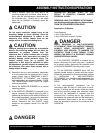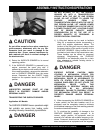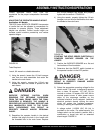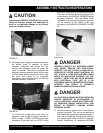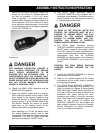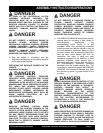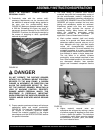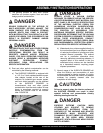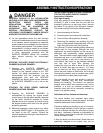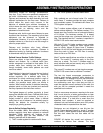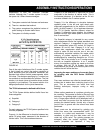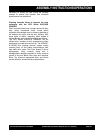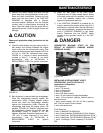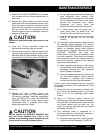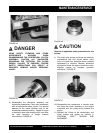
DFG-SERIES SURFACE GRINDERS OPERATION AND PARTS MANUAL REV #4 (05/28/09) PAGE 36
ASSEMBLY INSTRUCTIONS/OPERATIONS
DANGER
PROPERLY DISPOSE OF ALL ACCUMULATED
MATERIALS PER OSHA AND ENVIRONMENTAL
PROTECTION AGENCY CODES AND
REGULATIONS. MANY ACCUMULATED
MATERIALS CAN BE CLASSIFIED AS
HAZARDOUS AND REQUIRE PROPER
DISPOSAL PROCEDURES. CONTACT THE
APPLICABLE GOVERNMENT AND/OR PRIVATE
AGENCIES FOR SPECIFIC INFORMATION.
8) On job applications where the work process
creates a considerable amount of loose material,
it can become almost impossible to determine
proper material removal depths and the extent of
work already accomplished. The problem can be
compounded if a vacuum system is not utilized.
Loose material should be removed by sweeping
or other, appropriate processes and the
SURFACE GRINDER utilized until conditions
again warrant removing the accumulated
material.
STOPPING THE DFG/E SERIES ELECTRICALLY
POWERED SURFACE GRINDER.
1) Stopping the SURFACE GRINDER is
accomplished by moving the ON/OFF switch
located on the operator ha
ndle to the OFF
position. For safety considerations, it is also
recommended that the extension cord be
disconnected from both the SURFACE
GRINDER and electric power source whenever
the SURFACE GRINDER is not in use on the
jobsite
STOPPING THE DFG/G SERIES GASOLINE
POWERED SURFACE GRINDER.
1) Stopping the SURFACE GRINDER is
accomplished by moving the engine throttle
control lever to the idle speed position (depicted
by the turtle). Machines powered by Honda
engines can be then stopped by further moving
the engine throttle control lever until the ignition
system is grounded.
2) Machines powered by other engines may utilize
a separate ON/OFF switch. If so equipped, turn
the switch to the OFF position. Consult the
material supplied by the engine manufacturer for
specific information.
OPERATIONAL PARAMETERS AND TECHNIQUES
FOR THE DFG SERIES SURFACE GRINDER.
Application: All Models.
Early Age Grinding
Early age grinding is an alternative to floating and
trowelling. It gets it name from the fact that the
concrete is ground at an early age, after it h
as set
but before it has gained much structural strength.
The process usually involves the following steps:
1) Normal screeding of the floor.
2) Smoothing the floor surface with a skip float.
3) Cover the floor with polyethane sheeting.
4) Removing the sheeting and grinding the floor
down a uniform depth of approximately 1/32 inch
within 24 to 48 hours of the initial pouring.
The C06 and C10 silicon carbide grinding stones are
usually used for the process, although the multi
segmented, dry diamond blades can be use as an
alternative with substantially greater productivity
rates. The main benefit of early age grinding is that it
eliminates late work in cold weather. With ordinary
finishing methods,
a slab cast in the morning of a
cold weather day might not get finished trowelled
until very late at night. With grinding, the
construction crew are able to leave the job at the
end of a normal work day and return 1 or 2 days
later to finish the job. Early age grinding may not
reduce the total number of work hours, but it usually
eliminates the need for work at overtime rates, which
can substantially increase total project costs.
One side benefit of early age grinding is that the
process demands less skill than conventional
floating and trowelling. This makes it an attractive
process where skilled crew personnel may not be
available. It is also an excellent procedure for
concrete floors that will be eventua lly covered by
carpet or an applied coating.
Definitions of floor flatness and levelness
The terms flatness and levelness have poorly
understood meanings in everyday speech, but have
important distinctions in floor construction.
Flatness is defined as planarity or lack of curvature.
A more simple definition is that a flat floor is smooth
and free of bumps and dips. An unflat floor is bumpy
and wavy. Levelness is defined as horizontality or
lack of slope. A level floor is horizontal. A floor that is
unlevel is sloped or tilted.
A floor can be flat, but still not level. Some floors are
specifically designed to be unlevel; they can be



